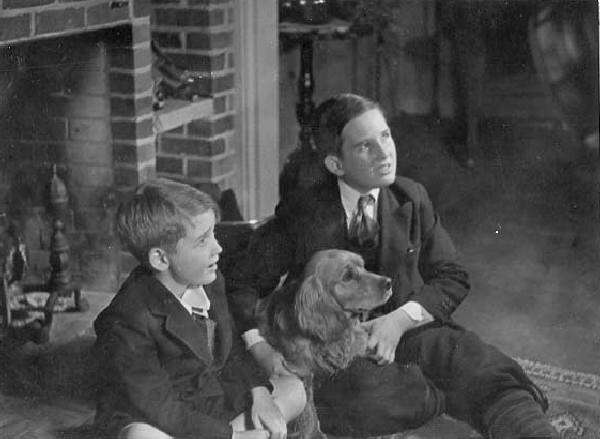
Boys' 1930s Pants and Trousers: Country Trends--United States

Figure 1.--Here we see two American brothers at home during the 1930s. Both boys wear the conservative dark suits favored by well-to-do families. Notice that the younger brother has a short pants suit while his older brother has a knickers suit. Notice that the younger brother wears ankle socks rather than kneesocks with his short psnts suit.
|
American boys wore short pants, knickers, and long pants in the 1930s. Kneepants were no longer worn. A range of factors such as social class, seasonal, and age affected what kinds of pants were worn. Shot pants seemed more common among affluent families, but there were also regional asnd seasonal fsactors. Younger American boys might wear short pants, especially during the summer. Shorts were also more commoin in the South. Some boys wore short pants all year round, but increasinly mothers chose knickers or long pant for the winter. This was increasingly common by the late 30s. Knickers continued, however, to be the dominant form of boys' trousers--especially for school age boys after the 1st or second grade (6-7 year olds). This was parrticularly true in the early 30s. Sears in their 1930 catalog advertised the popular knickers that most American schoolboys wore. Families might by short pants suits for younger boys and knicker suits for older boys. More and more boys wore kneesocks rather than long stockings. A good example here is Jake photographed with the family car in 1932. We begin to see more boys swearing ankle socks by the late 30s. We see more boys wearing long pants by the late 30s even some youngerr boys. Conventions vsaried from family to family. Some boys had lon pants play suits, but short pants or knicker suits. While knickers were declinning in popularity by the late 1930s, they were still quite common.
Many photographs from the late 30s show groups of boys with boys knockers and long pants prevalent. A good example is an unidentified group, perhaps from New York. Notice that two of the boys are wearing
knickers--one with the traditional patterned "golf" socks--while the
third boy is wearing long trousers. This is a good illustration of the end of the
knicker era and the beginning of the long trousers era for younger
boys.
As a result of fashion changes during World War II, they rapidly disappeared. We are not yet entirely sure why.
HBC

Navigate the Historic Boys' Clothing Web Site:
[Return to the Main American pants chronology page]
[Return to the Main pants 1930s chronology country page]
[Return to the Main 1930s trouser page ]
[Introduction]
[Activities]
[Biographies]
[Chronology]
[Cloth and textiles]
[Clothing styles]
[Countries]
[Topics]
[Bibliographies]
[Contributions]
[FAQs]
[Glossaries]
[Satellite sites]
[Tools]
[Boys' Clothing Home]
Navigate the Historic Boys' Clothing Web chronological pages:
[Early 19th century]
[Mid-19th century]
[The 1860s]
[The 1870s]
[The 1880s]
[The 1890s]
[The 1900s]
[The 1910s]
[The 1920s]
[The 1930s]
[The 1940s]
[The 1950s]
[The 1960s]
[The 1970s]
[The 1980s]
Navigate the Historic Boys' Clothing Web style pages:
[Skeleton suits]
[Eton suits]
[Norfolk jackets]
[Kilts]
[Knicker suits]
[Blazers]
[Short pants suits]
[Long pants suits]
Created: 5:26 AM 2/19/2006
Last updated: 5:33 PM 4/4/2006


